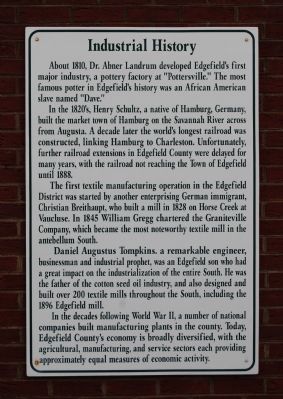Edgefield in Edgefield County, South Carolina — The American South (South Atlantic)
Industrial History
In the 1820's, Henry Schultz, a native of Hamburg, Germany, built the market town of Hamburg on the Savannah River across from Augusta. A decade later the world's longest railroad was constructed, linking Hamburg to Charleston. Unfortunately, further railroad extensions in Edgefield County were delayed for many years, with the railroad not reaching the Town of Edgefield until 1888.
The first textile manufacturing operation in the Edgefield District was started by another enterprising German immigrant, Christian Breithaupt, who built a mill in 1828 on Horse Creek at Vaucluse. In 1845 William Gregg chartered the Graniteville Company, which became the most noteworthy textile mill in the antebellum South.
Daniel Augustus Tompkins, a remarkable engineer, businessman and industrial prophet, was an Edgefield son who had a great impact on the industrialization of the entire South. He was the father of the cotton seed oil industry, and also designed and built over 200 textile mills throughout the South, including the 1896 Edgefield mill.
In the decades following World War II, a number of national companies built manufacturing plants in the county. Today, Edgefield County's economy is broadly diversified, with the agricultural, manufacturing, and service sectors each providing approximately equal measures of economic activity.
Topics. This historical marker is listed in these topic lists: Agriculture • Industry & Commerce. A significant historical year for this entry is 1810.
Location. 33° 47.4′ N, 81° 55.783′ W. Marker is in Edgefield, South Carolina, in Edgefield County. Marker is on Jeter Street. Marker is located in the greenspace in the northwest corner of the intersection of Jeter and Bumcombe Streets. Touch for map. Marker is in this post office area: Edgefield SC 29824, United States of America. Touch for directions.
Other nearby markers. At least 10 other markers are within walking distance of this marker. Religion & Education (here, next to this marker); A History of Violence (within shouting distance of this marker); Political Heritage (within shouting distance of this marker); The Name "Edgefield" (within shouting distance of this marker); Agricultural History (within shouting distance of this marker); Edgefield County (within shouting distance of this marker); Old Law Building (within shouting distance of this marker); The Booth-Toney Shootout of 1878 (within shouting distance of this marker); Israel Mukashy Building
(within shouting distance of this marker); Turner's Country Store (within shouting distance of this marker). Touch for a list and map of all markers in Edgefield.
Also see . . . Carolina Clay: The Life and Legend of the Slave Potter Dave. Dave made stoneware vessels from his early twenties until his mid-seventies, a span of over fifty years. (Submitted on October 17, 2008, by Brian Scott of Anderson, South Carolina.)
Credits. This page was last revised on December 9, 2021. It was originally submitted on October 17, 2008, by Brian Scott of Anderson, South Carolina. This page has been viewed 1,230 times since then and 13 times this year. Photos: 1, 2. submitted on October 17, 2008, by Brian Scott of Anderson, South Carolina.

